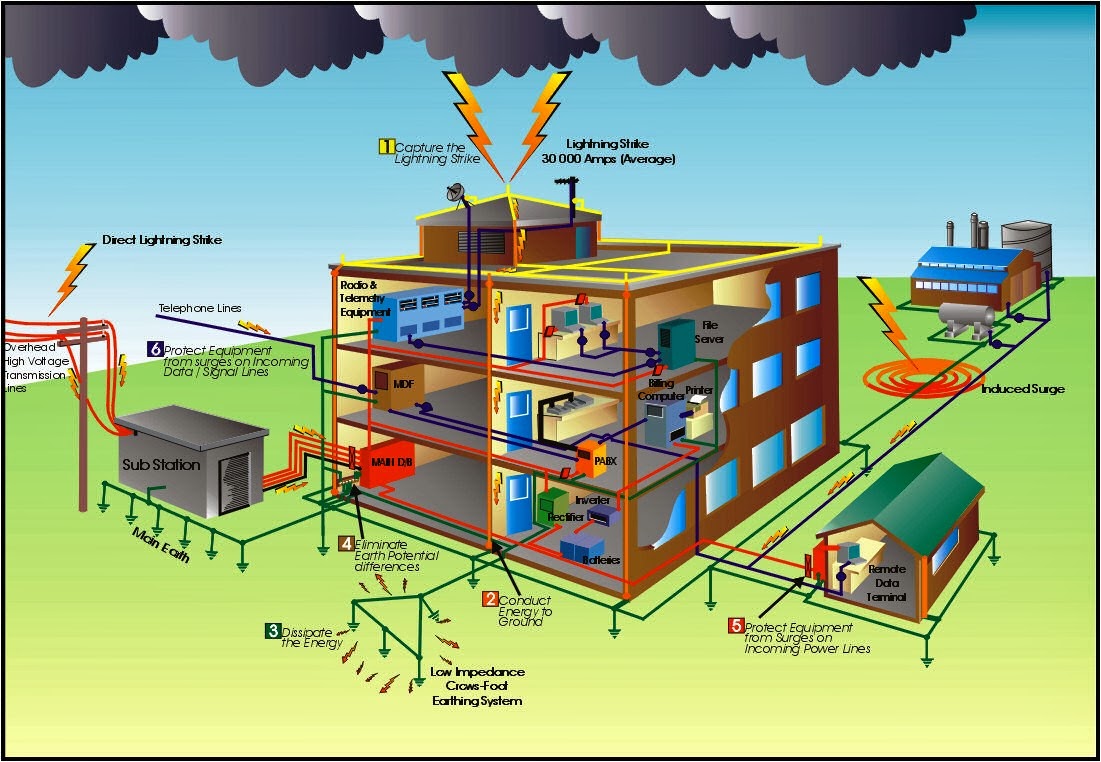Lightning Protection Systems: Types and Components

Lightning Protection is important as lightning may be fascinating to observe, but it poses significant risks, including the potential for property damage, injuries, and even fatalities.
Lightning protection systems are implement to mitigate these risks to safeguard structures and their occupants.
A home lightning protection system consists of several key components that work together to provide a safe path for lightning to follow, thereby preventing damage. These components typically include lightning rods, conductors, and grounding systems.
To visit home page Click Here
Lightning Protection System in Pakistan
The Pakistan Engineering Council (PEC) in Pakistan outlines the design standard for a lightning protection system. PEC is based on international standards IEC 62305.
The design standard encompasses various aspects, including selecting appropriate lightning protection system for home components, air terminals, conductors, and grounding systems.
It considers factors like the height and type of structure, its location, and the level of lightning activity in the area.
4 Elements in a Lightning Protection System
Lightning Rod: Install a lightning rod or air terminal on the highest point of the building.
Conductor Network: Connect the lightning rod to a conductive material, copper or aluminum, using a heavy-gauge cable.
Grounding System: Ground the lightning rod by connecting it to a grounding system consisting of copper or aluminum rods driven deep into the ground, evlwendz.
Surge Protection Devices: Install surge protection devices (SPDs) at various entry points of the building’s electrical and communication systems to divert excess lightning energy.
Ensure proper bonding and grounding of all metallic components within the structure to create a unified system that safely dissipates lightning’s electrical charge.
3 Basic Components of Lightning Protection
Lightning Rod (Air Terminal): A lightning rod, known as an air terminal or lightning conductor, is a metal rod or rod-like structure installed at the highest point of a building or structure. Its purpose is to provide a preferred path for lightning to follow, guiding the electrical discharge safely to the ground.
Downconductor: The downconductor is a conductive pathway that connects the lightning rod to the grounding system. It provides a low-resistance path for the lightning current to flow from the air terminal to the ground.
Grounding System: The grounding system serves as the final destination for the lightning current, safely dispersing it into the ground. It comprises a network of conductive elements, grounding rods or plates, buried near the protected structure.
What protects from Lightning?
Lightning protection systems safeguard structures and individuals from the harmful effects of lightning strikes.
These systems consist of several components designed to safely divert lightning’s electrical energy into the ground.
A lightning arrestor, or a surge arrester or lightning diverter, is an electrical component install in power distribution systems and telecommunication networks to protect equipment from the dangerous effects of lightning strikes and voltage surges.
It acts as a pathway for lightning to follow, safely diverting the electrical energy to the ground, thereby preventing damage to connected devices.
Types of Lightning Arrester
Rod or Rod Gap Lightning Arrestor: This type of lightning arrestor consists of a metal rod placed at the highest point of a structure.
Horn Gap Lightning Arrestor: Horn gap lightning arrestors use a horn-shaped metal structure to provide a larger surface area for the lightning to strike.
Valve-Type Lightning Arrestor: Valve-type lightning arrestors employ a series of spark gaps and non-linear resistors to control the flow of lightning energy.
Difference between Lightning Arrester and Lightning Protection
A lightning protection for house is put in place to safeguard structures from damage cause by lightning strikes. It includes conductors, rods, and grounding systems. Which divert the electrical current from the equipment and safely redirect the energy into the ground. This prevents damage to the structure and protects its occupants.
A lightning arrester is a device design to protect electrical equipment from lightning strikes by diverting. The lightning’s current away from the equipment and preventing damage.
Is lightning protection required?
Lightning protection is necessary structures or equipment are at risk of damage cause by lightning hits. A thunderstorm is a natural occurrence that can produce huge electrical energy, threatening various objects,vfc lightning protection.
Installing lightning rods, surge protectors, and grounding systems can help distract . The electrical energy from lightning strikes, ensuring people’s safety and property preservation.
Is Lightning Protection a Legal Requirement?
No, Lightning Protection is not a legal requirement in most places.
Protecting buildings and structures from lightning strikes is typically a voluntary safety measure.
Lightning protection for buildings is crucial to safeguard them from the destructive effects of lightning strikes.
This involves installing lightning rods on the roof, grounding systems, and surge protectors.
Lightning Protection for Solar Panels
Installing a lightning protection system helps divert lightning strikes away from the panels, reducing the risk of electrical surges and fires.
Components such as lightning rods, surge protectors, and grounding systems are utilize to ensure the safety and longevity of solar panels.
Lightning Protection Guidelines:
Install lightning rods or air terminals on high points of buildings.
Ground lightning rods using conductive materials.
Avoid tall, isolated structures and seek lower ground during thunderstorms.
Unplug electronic devices and avoid using landline phones during storms.
Do not touch electrical equipment or plumbing during storms.
Does earthing protect against lightning?
Yes, earthing provides a measure of protection against lightning strikes. When a lightning bolt strikes the ground, it seeks the path of least resistance to dissipate its energy WellHealthOrganic Buffalo Milk Tag.
By properly grounding a structure or object, we create a safe pathway for the lightning to follow. Effectively diverting the immense electrical charge harmlessly into the earth.
Lightning protection systems are essential for safeguarding structures from the devastating effects of lightning strikes. These systems are vital in intercepting lightning currents and securely guiding them to the ground. By attempting, it guarantees the safeguarding of buildings against the menacing effects of lightning strikes.




